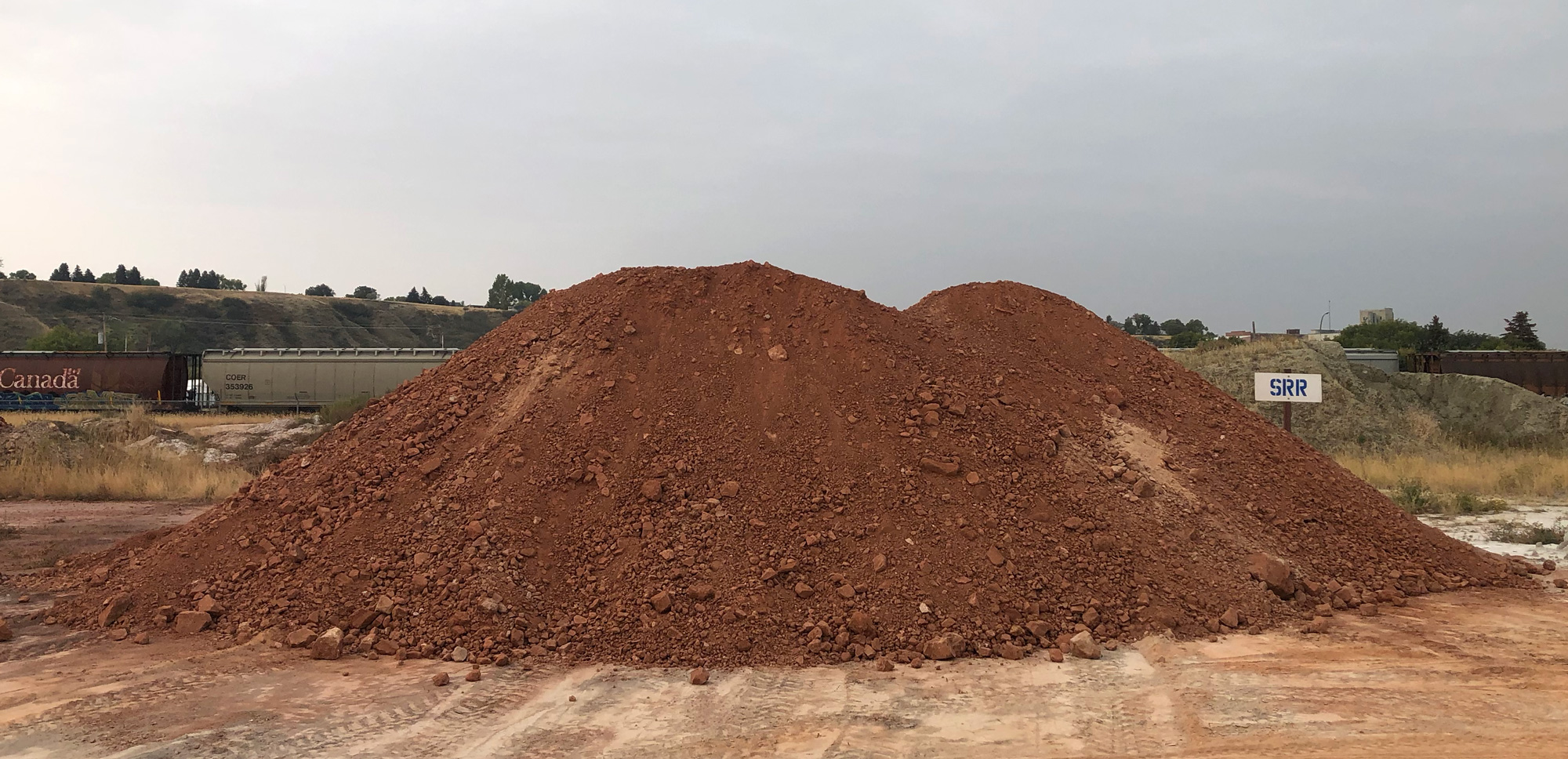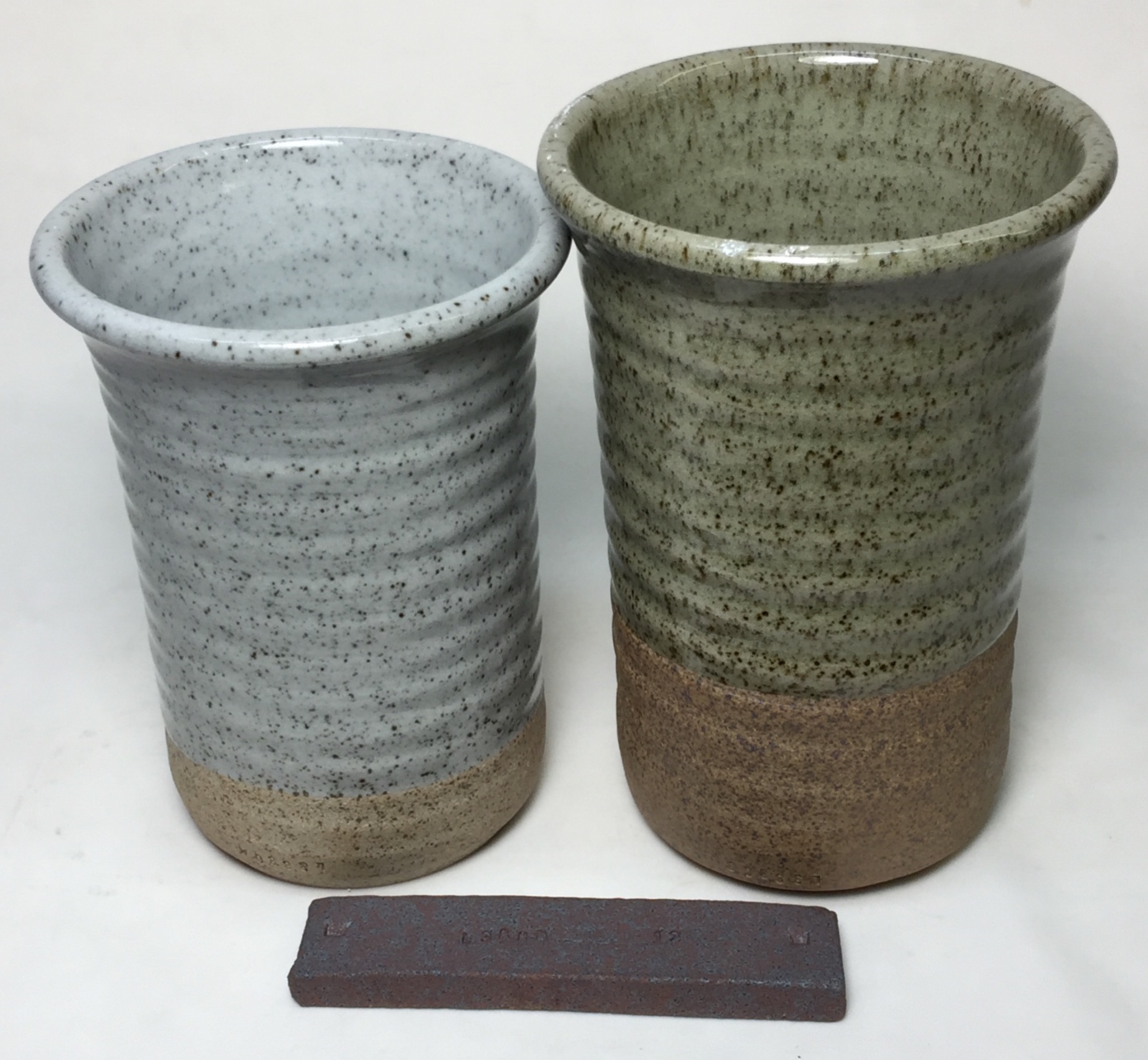| Monthly Tech-Tip | No tracking! No ads! |
Saint Rose Red being delivered. Look what it does at cone 10R!
We get this clay from St. Rose, Manitoba. Four tandem loads arrived this week. Just seeing the pile inspires me to make more pieces! It is a red fireclay and it is highly unusual. St. Rose Red has issues. They at first seem to be problems, but in combination they give it magic powers! It fires with very heavy iron speckling. The iron pigmentation is so high that it burns almost black at cone 10R. It has low plasticity. It shivers glazes: The vase on this picture lasted an hour after kiln exit, it spontaneously fractured because of the outward pressure from the under-compression glaze on the inside. But, by combining St. Rose Red with our more vitreous clays, which are highly plastic, we can make H440 and H443. A mix of only 45 St. Rose with 40 Ball clay and 15 feldspar produces a rustic metallic surface (like the cup shown). Such a body cannot be made from a low fire red clay (like RedArt), it would just warp and collapse in the kiln. It is the refractory character, heavy pigmentation, iron speckling and low plasticity of St. Rose that make metallic ware possible.
Related Pictures
The stockpile of St. Rose Red fireclay at the Plainsman plant

This picture has its own page with more detail, click here to see it.
This is the lump form of Plainsman St. Rose Red clay, as received from the quarry. The bright red color is natural iron oxide. That iron cannot be washed out, it is part of the clay crystal structure. The pigmentation is heavy enough that even when this material is a minor part of a body recipe, that body will still fire to a dark color. The color and high cost of St. Rose Red means that it is always heavily diluted with other clays, many of which are highly plastic. Because St. Rose is non-plastic it is a perfect complement to these. It is also refractory, it melts at a much higher temperature than typical clays. It is mined near St. Rose, Manitoba.
Plainsman Red Fireclay (Fire-Red)

This picture has its own page with more detail, click here to see it.
Top to bottom: Cone 10 reduction, cone 10, 9, 8, 7 oxidation. Fire-Red is a mix of St. Rose Red fireclay, M2 Montana medium fire red clay with some dark burning A1 ball clay. This blend is less refractory than pure St. Rose Red and much more plastic, thus more suitable as a body addition. The color shift between cone 9 and 10 oxidation occurs because of the fluxing action of M2.
Raw clay delivery in a live bottom trailer
We are currently getting about 20 loads of M2 from our Montana quarry. This clay is what makes it possible for us to make clay bodies like M390 and M350. This super-long trailer has a conveyor belt on the bottom, driven by a powerful hydraulic motor - it conveys the material out of the back. The tub empties clean and enables dumping the clay at a controlled pace. These are much safer than the tandem dumps we have used in the past.
Laguna B-Mix on Steroids: Wedge in some Plainsman Fire-Red!

This picture has its own page with more detail, click here to see it.
Both pieces have a transparent glaze, G1947U. The Fire-Red (a blend of Plainsman A1/M2 and St. Rose Red native clays) was slurried up, dewatered to plastic form and then wedged into the B-Mix (a commercial porcelainous whiteware body made by Laguna Clay). The left piece has 10% added Fire-Red, the other 20%, the bar in front shows the pure material). The A1 clay supplies most of the speckle, the St. Rose Red and M2 impart the color. This addition does not affect the working properties of BMix (it is highly plastic). An added benefit is that pieces dry harder and with less cracking. Fired strength and maturity are minimally affected (porosity stays around 1%). With a 20% addition, the surface of the unglazed clay is almost metallic. Silky matte glazes, like G2571A, are also stunning on a body like this.
Plainsman Fire-Red reduction fired vase

This picture has its own page with more detail, click here to see it.
Fire-Red clay is a 50:50 mix of St. Rose Red and M2 with 10% A1 bentonitic clay. The St. Rose is a red fireclay, not useful on its own in reduction firing (because it is too refractory). The M2 supplies iron staining but also natural feldspar to mature the body enough to make it fire strong. The A1 clay contributes iron pyrite speckle and plasticity (in heavy reduction, with a little more feldspar added, this body can fire metallic). The glaze is G2571A bamboo. This piece exhibits the trimming ring (one third of the way up) which divides the thrown surface (upper) with the trimmed one (lower).
Videos
Links
| Materials |
Saint Rose Red
|
Got a Question?
Buy me a coffee and we can talk

https://backup.digitalfire.com, All Rights Reserved
Privacy Policy

